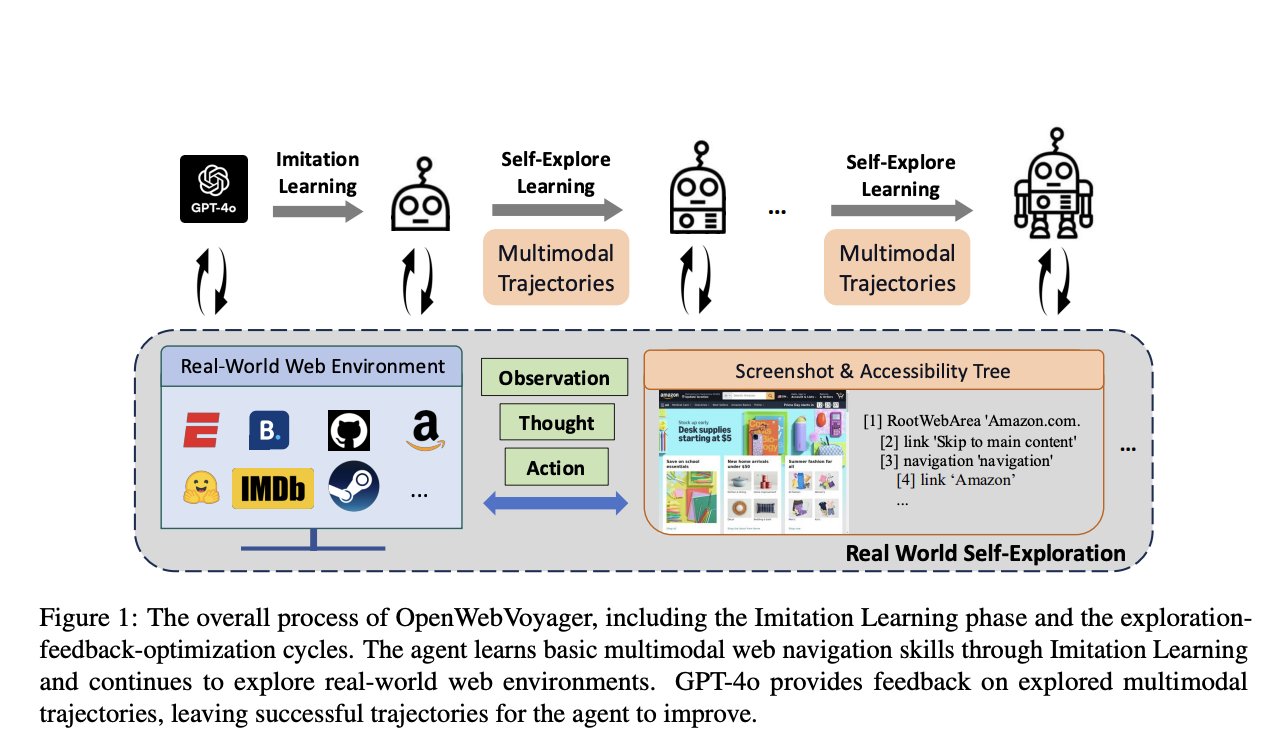
Challenges in Creating Autonomous Web Agents
Designing autonomous agents for complex web navigation is challenging, especially when they need to understand both text and images. Traditional agents work in limited, controlled environments, which hinders their effectiveness in real-world applications. A major hurdle is enabling these agents to interpret mixed content without guidance, which is a significant AI challenge. Additionally, they must adapt continuously to the ever-changing online landscape.
Current Limitations of Existing Approaches
Many existing solutions rely on large language models, like GPT-4o, which work well in text-based situations but struggle in real-world scenarios. Some models like WebVoyager combine images and text, but they are based on closed-source methods and controlled environments, making them less adaptable. Most approaches also depend on consistent reward signals, which are often absent in actual tasks. Although some open-source models exist, they lack the deep contextual understanding needed for complex navigation.
Introduction to OpenWebVoyager
Researchers from Zhejiang University, Tencent AI Lab, and Westlake University have developed OpenWebVoyager, an open-source framework promoting continuous self-improvement in real-world web environments. The framework uses an iterative feedback loop in imitation learning, allowing agents to imitate and learn basic navigation skills before enhancing their performance through exploration and feedback.
How OpenWebVoyager Works
OpenWebVoyager utilizes the Idefics2-8b-instruct model to process images and text, improving its understanding of real-world scenarios. It employs a cycle of exploration, feedback, and optimization, where the model continuously evaluates and updates its learning based on performance. This allows agents to learn independently and optimize their navigation skills over time.
Implementation Steps
The framework includes tasks from various domains, like e-commerce and news, gathered from 48 websites with 1516 specific queries. By using a combination of accessibility trees and screenshots, OpenWebVoyager effectively handles complex web layouts. The iterative process allows the model to gather new queries and retain successful navigation paths, enhancing its adaptability to visual elements on web pages.
Results and Performance Improvement
OpenWebVoyager has shown significant success in web navigation benchmarks. After the initial learning phase, the agent’s success rate improved from 19.9% to 25.8% after three optimization cycles. In tests with new tasks, its success rate jumped from 6.3% to 19.6% in known domains and nearly 4% in new areas. These improvements highlight OpenWebVoyager’s effectiveness in enhancing web navigation capabilities.
Conclusion: The Future of Web Navigation
OpenWebVoyager marks a significant advancement in AI-driven web navigation. It offers a self-optimizing framework that improves through iterative learning cycles. By integrating imitation learning, exploration, and automated feedback, it enhances the scalability of autonomous web agents across various domains without needing extensive retraining. This innovative approach could transform web navigation in sectors such as e-commerce and information retrieval.
Get Involved!
Check out the Paper and GitHub Page. Follow us on Twitter, join our Telegram Channel, and connect on LinkedIn. If you appreciate our work, subscribe to our newsletter and join our 55k+ ML SubReddit.
Opportunity for Collaboration
Consider a Sponsorship Opportunity with us to promote your research, product, or webinar to over 1 million monthly readers and 500k+ community members.
Elevate Your Company with AI
Stay competitive and leverage OpenWebVoyager to redefine your operations. Identify automation opportunities, define measurable KPIs, select suitable AI tools, and implement gradually. For AI KPI management advice, contact us at hello@itinai.com. Stay updated on AI insights via Telegram or Twitter.
Transform Sales and Customer Engagement
Discover how AI can revolutionize your sales processes and customer interactions. Explore more at itinai.com.























